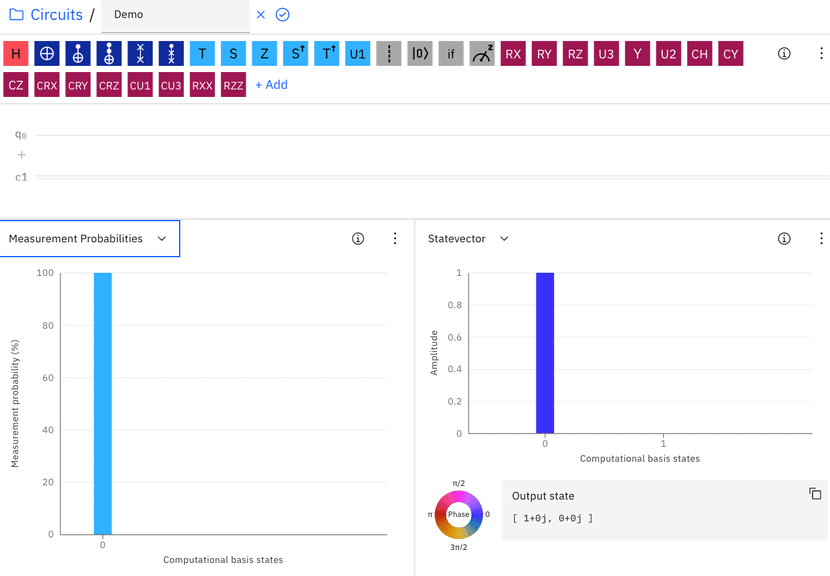The goal of quantum computing is to create the next generation of computers and overcome classic computing limits. The goal of quantum computing is to create the next generation of computers and overcome classic computing limits.
Despite the progress, there are still unknown areas in this emerging field.
This article is an introduction to the basic concepts of quantum computing. This article will explain what quantum computing is, how it works and the differences between a quantum machine and a standard device. Defined Quantum computing is a new generation of computers based on quantum mechanics, a physics branch that studies atomic and subatomic particles. These supercomputers perform computations at speeds and levels an ordinary computer cannot handle. These are the main differences between a quantum device and a regular desktop:
Different architecture:
Quantum computers have a different architecture than conventional devices. For example, instead of traditional silicon-based memories or processors, different technology platforms, such as super conducting circuits and trapped atomic ions are utilized.
Computational intensive use cases:
A casual user might not have much use for a quantum computer. The computational-heavy focus and complexity of these machines make them suitable for corporate and scientific settings in the foreseeable future.
- Unlike a standard computer, its quantum counterpart can perform multiple operations simultaneously. These machines also store more states per unit of data and operate on more efficient algorithms.Incredible processing power makes quantum computers capable of solving complex tasks and searching through unsorted data.
- What is Quantum Computing Used for? Use Cases in IndustryThe adoption more powerful computers is beneficial to all industries. However, some areas already stand out as excellent opportunities for quantum computers to make a mark:
Healthcare:
Quantum computers help develop new drugs at a faster pace. DNA research also benefits greatly from using quantum computing.
Cybersecurity:
Quantum programming can advance data encryption. The new Quantum Key Distribution (QKD) system, for example, uses light signals to detect cyber attacks or network intruders.
- Finance: Companies can optimize their investment portfolios with quantum computers. Improvements in fraud detection and simulation systems are also likely.
- Transport: Quantum computers can lead to progress in traffic planning systems and route optimization.
- What are Qubits?The key behind a quantum computer’s power is its ability to create and manipulate quantum bits, or qubits.
- Like the binary bit of 0 and 1 in classic computing, a qubit is the basic building block of quantum computing. Whereas regular bits can either be in the state of 0 or 1, a qubit can also be in the state of both 0 and 1.Here is the state of a qubit q0 :q0 = a|0> + b|1>, where a2+ b2 = 1The likelihood of q0 being 0 when measured is a2. Its probability of being 1 is b2. A qubit is probabilistic and can be 0 or 1 at the same. For the qubit q0, where a = 1 & b = 0, the qubit q0 corresponds to a bit of 0. When measured, there is a 100% probability of getting to a value 0. If a = 0, and b = 1, q0 will be equivalent to the classical bit 1. Let’s examine an empty circuit with a qubit q0 in the IBM Circuit Composer (Figure 1). The graph “Measurement Probabilities” shows that the q0 is 100% likely to be measured as 0. The “Statevector” graph shows the values of a and b, which correspond to the 0 and 1 “computational basis states” column, respectively.
In the case of Figure 1, a is equal to 1 and b to 0. The difference in processing is due to two quantum properties: superposition and entanglement.
Figure 1. Empty circuit with one qubit. The difference in processing is due to two quantum properties: superposition and entanglement.
When 0 < a and b < 1, the qubit is in a so-called superposition state. When measured, the qubit can jump from 0 to 1 in this superposition state. The probability of getting to 0 or 1 is defined by a2 and b2.
The Hadamard Gate is the basic gate in quantum computing. The Hadamard Gate transforms the qubit into a superposition from a state that is not in superposition. In a superposition, it is possible to measure the qubit as 0. The qubit can also end up in a superposition state. After passing the Hadamard gate, the “Measurement Probabilities” graph shows that there is a 50% chance of getting a 0 or 1 when q
0 is measured.Figure 2: Qubit q0 in superposition stateThe “Statevector” graph shows the value of a and b, which are both square roots of 0.5 = 0.707. The probability for the qubit to be measured to 0 and 1 is 0.7072
= 0.5, so q
0 is now in a superposition state.What Are Measurements?When we measure a qubit in a superposition state, the qubit jumps to a non-superposition state. The qubit will be forced out of superposition by a measurement. It will then become either 0 (or 1.0) or 1.1001010If the qubit is already in the non-superposition of 0 and 1, it won’t change. Let’s add a measurement to the circuit (Figure 3): We measure q0 after the Hadamard gate and output the value of the measurement to bit 0 (a classical bit) in c1:Figure 3: Add a measurement operation to qubit q0
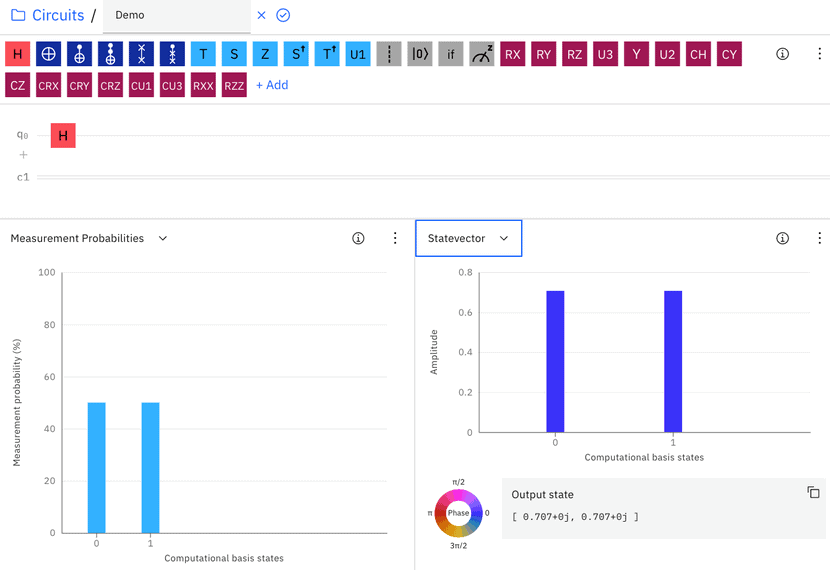
0 measurement after the Hadamard Gate, we send the circuit to run on an actual quantum computer called “ibmq_armonk.” By default, there are 1024 runs of the quantum circuit. Figure 4 shows that 47.4% of time the measurement for q0
is 0. The other 52.6% are measured as 1. The other 52.6% of times, it is measured as 1:
Figure 4: Results of the Hadamard gate from a quantum computer
The second run (Figure 5) yields a different distribution of 0 and 1, but still close to the expected 50/50 split:
Figure 5: Results of 2nd run of Hadamard gate from a quantum computerEntanglement in Quantum ComputingIf two qubits are in an entanglement state, the measurement of one qubit instantly “collapses” the value of the other. Even if two entangled quantum bits are located far apart, the same effect occurs. It is not necessary to measure the second quantum. Let’s look at an illustration. The CNOT gate is a quantum operation that converts two untangled quanta into entangled states. To demonstrate, we add another qubit, q
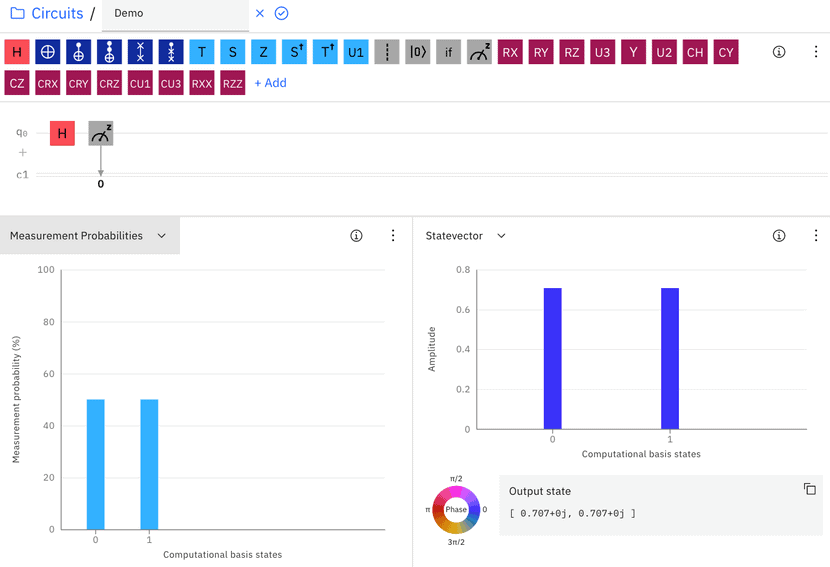
which is initially initialized to 0. The two qubits have been untangled before the CNOT gates, and q0 will be 0 by default. Figure 7 shows the “Measurement probabilities” graph, which now shows that there is a 50% chance of (q1 and q0) to be (0, 0), and a 50% chance of being (1, 1) when measured. Figure 7 shows the “Measurement probabilities” graph, which now indicates that (q
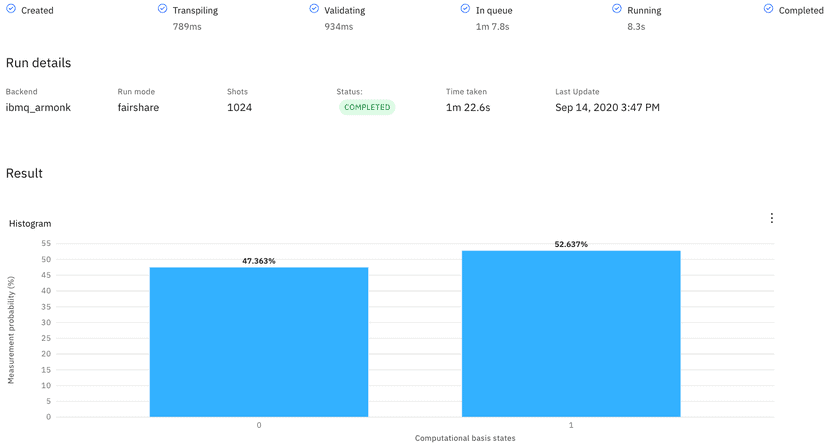
and q
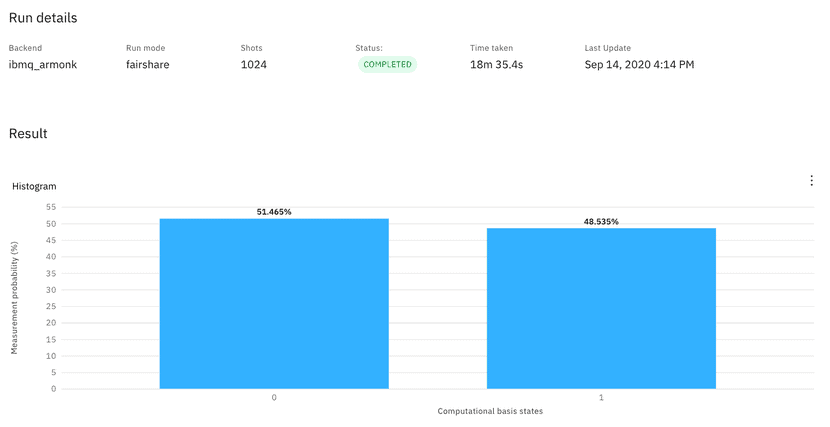
) have a 50% chance to be (0, 0), while 50% are (1, 1), when measured. We know the value of the other qubit once we have determined the value for one. In such a state, q
0
and q
1 are entangled.Let us run this on an actual quantum computer and see what happens (Figure 8):Figure 8: Results of CNOT gate on qubits (q1, q0) from a quantum computerWe are close to a 50/50 distribution between the ’00’ and ’11’ states. Due to the high error rate of quantum computers, we also see unexpected occurrences such as ’01 and ’10. While error rates for classical computers are almost non-existent, high error rates are the main challenge of quantum computing.The Bell Circuit is Only a Starting PointThe circuit shown in the ‘Entanglement’ section is called the Bell Circuit. The Bell Circuit is often referred to as the Hello World program for quantum computing. It shows qubits and superposition. 1> in the formulation of qubit?Why do a2 and b2
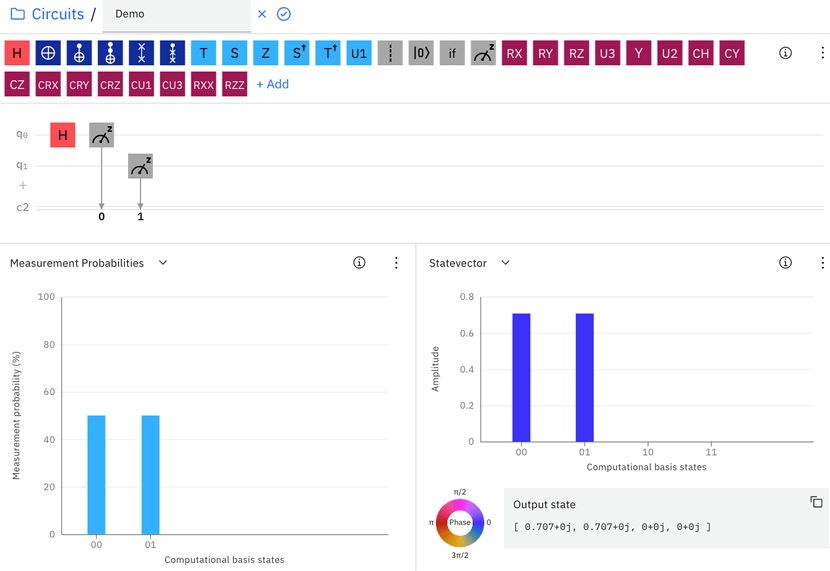
What are the mathematical representations of the Hadamard and CNOT gates? Why do gates put qubits into superposition and entanglement states?Can we explain the phenomenon of entanglement?There are no shortcuts to learning quantum computing. The field touches on complex topics spanning physics, mathematics, and computer science.There is an abundance of good books and video tutorials that introduce the technology. These resources usually cover prerequisite concepts such as linear algebra, binary computing, and quantum mechanics. Solutions to financial portfolio optimization and vehicle routing, for example, are great starting points for learning about quantum computing.The Next Step in Computer EvolutionQuantum computers have the potential to exceed even the most advanced supercomputers. Quantum computing could lead to breakthroughs for science, medicine and machine learning. It can also be used in construction, finance, transportation, emergency services, and even the field of construction. Quantum computing will cause major disruptions over the next few years, as new advances are made every day.
